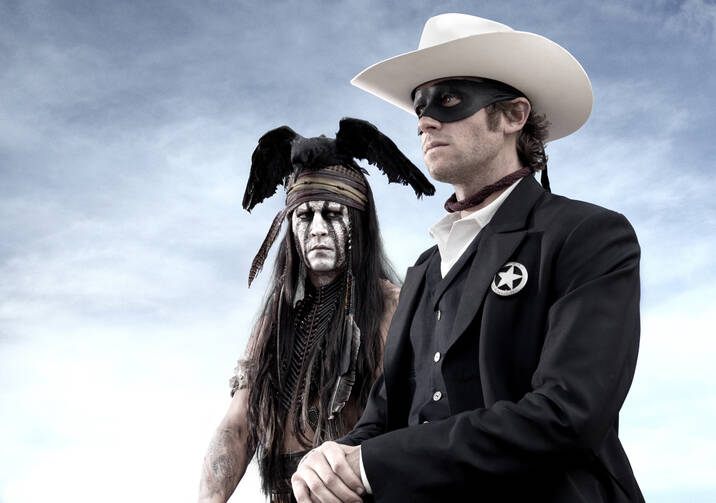“Nowhere in the pages of history can be found a greater champion of justice! Return with us now to those thrilling days of yesteryear! From out of the past come the thundering hoofbeats of the great horse Silver...The Lone Ranger rides again!"
By now everyone who cares at all about the history of popular culture and reads film reviews knows that, figuratively, the Long Ranger has fallen off his horse. I suspect that even though the last radio broadcast was in 1954, a vast audience was yearning for this film to be good. Everyone over 65 still has “Hi-yo Silver! Away” embedded in his or her deepest consciousness, and everyone else has either seen the TV series (1949-57) or the too many bad attempts to bring it back, as in the flopped 1981 film starring Klinton Spilsbury, with a dubbed voice, in his first and last flick, or in a forgotten TV movie in 2003 or numerous cartoons.
Somehow the ghost of the long-gone masked man has permeated the culture. Everyone still knows who Tonto, his “faithful Indian companion,” was—or is. Everyone can hum the “William Tell Overture” without knowing it’s from an opera and laugh at contemporary Lone Ranger jokes like: The Lone Ranger and Tonto are pinned down and surrounded by Indians on the war path, galloping around them in a murderous circle as the doomed duo fight for their lives. The Lone Ranger turns to Tonto and says, “Well, kimo sabe, it looks as if we’re in for it.” Tonto replies, “What do you mean, we, whiteman”?
I saw the current version at the magnificent Zeigfeld theater, with its huge screen ideal for epics like “Lawrence of Arabia,” with its dazzling desert vistas and battle scenes. “The Lone Ranger” too dazzles with desert vistas where cowboys and cavalry gallop through the same Monument Valley of John Ford classic westerns—even though Monument Valley is in Utah and this film supposedly takes place in Texas.
One of the strengths of the original 1933-1954 radio program was that it took itself seriously. Half of its audience were adults. When, back in Trenton, N.J., my brother David and I went out to play after dinner, we stopped to pick up our friend Lane Grover who lived a few houses down. If it was 7:30 on a Monday, Wednesday or Friday night, when we entered the living room we had to hush up. Mr. Van Buskirk, Lane’s grandfather, had his ear pinned to the radio; nothing took precedence over “The Lone Ranger.” Mr. Van Buskirk was a veteran of the Spanish American War! This was not a fantasy “return to yesteryear,” he had grown up in something close to the culture he was listening to. And the simple theme of a mysterious brave and good man and his Indian friend who ride into the lives of people who need them, who save victims of injustice and ride away without waiting for thanks, held a universal appeal that satisfied the generations of the Spanish American War, World War I and World War II and the Korean War.
And the classical music providing the atmosphere gave it a timelessness that pop hits would have destroyed. Besides the familiar William Tell opening and closing, Smetena’s “Die Moldau” and Liszt’s “Les Preludes,” signaled the passage of time, usually preceded by the Lone Ranger explaining, “Now Tonto, here is my plan . . .” Wagner’s “Rienzi” overture was perfect for cavalry charges as the troops galloped to the rescue.
I saw this “Lone Ranger” just a few days after watching the latest James Bond adventure fantasy, “Skyfall,” and was stunned by the similarities. Neither took itself or the audience seriously. “Skyfall” opens with a motorcycle chase over the rooftops of an exotic foreign capital, as if motorcycles can jump from roof to roof. “The Lone Ranger” climaxes as a runaway train containing all the characters with guns pointed at each other roars through tunnels and up and down mountains as the Lone Ranger mounted on Silver gallops at 65 miles and hour across the roofs of the bouncing cars. It reminded me more than anything of a Bugs Bunny cartoon.
The film is generally faithful to the original plot wherein the Lone Ranger, with his brother Dan, as a deputy Texas Ranger is shot in ambush by super-ugly outlaw Butch Cavendish and left for dead. Tonto finds him among the corpses and nurses him back to life and a new identity. Ironically I was reminded of the 1941 episode where the actor who played the Lone Ranger, with a deep baritone voice, was killed in an auto accident and the script writers had to adapt the story so the listeners would not notice the voice-change in the new actor and hero Brace Beemer. So they had the Lone Ranger wounded in battle and speaking only a few words as gradually Tonto secretly nursed him back to health.
This film has one redeeming quality: the final train battle, silly as it is, is rescued not by the script but by Rossini’s music. The “William Tell Overture” composed for marching Swiss soldiers, is perfect for galloping horses, even on the top of a train.
Dear Hollywood, please try again; but you can’t expect an audience to respect your work if you ridicule it yourself.








